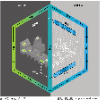The evolution of network virtualization and native artificial intelligence (AI) paradigms have conceptualized the vision of future wireless networks as a comprehensive entity operating in whole over a digital platform, with smart interaction with the physical domain, paving the way for the blooming of the Digital Twin (DT) concept. The recent interest in the DT networks is fueled by the emergence of novel wireless technologies and use-cases, that exacerbate the level of complexity to orchestrate the network and to manage its resources. Driven by AI, the key principle of the DT is to create a virtual twin for the physical entities and network dynamics, where the virtual twin will be leveraged to generate synthetic data and offer an on-demand platform for AI model training. Despite the common understanding that AI is the seed for DT, we anticipate that the DT and AI will be enablers for each other, in a way that overcome their limitations and complement each other benefits. In this article, we dig into the fundamentals of DT, where we reveal the role of DT in unifying model-driven and data-driven approaches, and explore the opportunities offered by DT in order to achieve the optimistic vision of 6G networks. We further unfold the essential role of the theoretical underpinnings in unlocking further opportunities by AI, and hence, we unveil their pivotal impact on the realization of reliable, efficient, and low-latency DT.
翻译:网络虚拟化和原生人工智能(AI)模式的进化,构思了未来无线网络作为一个全面的实体,在数字平台上运行,智能地与物理域交互,为数字孪生(DT)概念的兴起铺平了道路。DT网络的最近兴趣受到新型无线技术和应用实例的推动,这些实例增加了协调网络和管理其资源的复杂性水平。由AI驱动,DT的关键原则是为物理实体和网络动态创建虚拟双胞胎,其中将利用虚拟双胞胎生成合成数据并提供按需的AI模型训练平台。尽管人们普遍认为AI是DT的种子,但我们预计DT和AI将成为彼此的促进因素,以克服彼此的局限性并互补彼此的利益。在本文中,我们深入探讨DT的基本原理,揭示了DT在统一模型驱动和数据驱动方法方面的作用,并探索了DT提供的机会,以实现6G网络的乐观愿景。我们进一步阐明了理论基础在解锁AI进一步机会方面的重要作用,因此,我们揭示了它们对实现可靠、高效和低延迟DT的至关重要作用。



